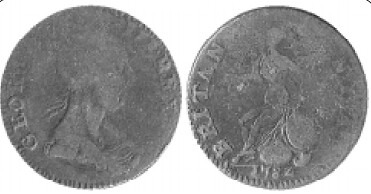
PREV ARTICLE
NEXT ARTICLE
FULL ISSUE
PREV FULL ISSUE
MORE ON DELAWARE'S MONEY BEACH COINSRon Ward writes: There are a number of references to the "Faithful Steward" wreck off the coast of Delaware in the Internet. One mentions that 400 barrels of copper coins were on board to be used as currency in the American Colonies. In 1999 I purchased a "Shipwreck Coin" from a dealer in Magnolia, DE who said it was washed ashore on a beach. I identified it as a George III, Irish Hibernia halfpenny with a 1782 date.
1) www.discoversea.com/Delaware's-Coin-Beach.html

www.discoversea.com/Delaware's-Coin-Beach.html Byron Weston writes: I believe I can offer Dick Doty some clarity about the 1784 contemporary counterfeit halfpenny that was found on Coin Beach with the attached article from CNL
Byron attached a copy of his article from the August 2009 issue of THE COLONIAL NEWSLETTER, titled Batty 3826: Vlack 14-84A Reconsidered. Here's an excerpt relating to the "Coin Beach" coins. Thanks!
-Editor

Figure 12: "Coin Beach" 3826/14-84A. One ground found example of 3826/14-84A, although not found using a metal detector, does perhaps offer a clue as to its origin because of where it was found.28 This example was found sometime in the 1930s or 1940s according to an online Yahoo egroup member by his grandfather on what is known as “Coin Beach,” near Rehoboth Beach, Delaware. Several years ago this author examined a hoard of 54 counterfeit halfpence that were also “Coin Beach” finds collected in the 1930s. This hoard contained a nearly equal division of Irish and English halfpence. Original photos of this example more recently shared with the author reveal that the surfaces and patination are consistent with the hoard coins this author examined nearly a decade earlier. Coins found here have traditionally been assigned to the wreck of the Faithful Steward,29 whose last port of call prior to sinking off the Delaware coast in 1785 was Londonderry, Ireland. This suggests a possible Irish origin for 3826/14-84A (see figure 12). The online discussion of this find, along with subsequent discussions, 30 revealed that several recently acquired examples of 3826/14-84A came from England. Unfortunately American owners or sellers of such pieces are not so forthcoming with this minor detail about the origin of these specimens. This anecdotal evidence concerning specimens emanating from the other side of the Atlantic, combined with the knowledge that two specimens were documented by Batty and Hammond, suggests that like the 1781 and 1785-dated counterfeits, 31 3826/14-84A had probably also circulated contemporaneously in both Britain and America.
To read the earlier E-Sylum articles, see:
GEORGE III COPPERS WASHING UP ON DELAWARE'S MONEY BEACH
(www.coinbooks.org/esylum_v15n42a24.html)
The Numismatic Bibliomania Society is a non-profit organization promoting numismatic literature. See our web site at coinbooks.org. To submit items for publication in The E-Sylum, write to the Editor at this address: whomren@gmail.com To subscribe go to: https://my.binhost.com/lists/listinfo/esylum All Rights Reserved. NBS Home Page Contact the NBS webmaster 
|